
As you prepare to purchase a new house or perhaps refinance your existing house, estimating your new monthly note (obligation) to plan your financial obligations is important. There are many variables at play here but let us consider the key elements in establishing your monthly note.
How do I estimate my mortgage payment?
1. How much do you need to borrow?
First, establish the amount of money you will need from your mortgage lender. To obtain the mortgage loan, there is a long list of documents required by your mortgage lender to qualify for a loan. Be prepared! For this demonstration, we will assume you meet the obligations necessary for a mortgage loan. Some mortgage considerations require a minimum amount of the total loan be paid by the borrower and is commonly referred to as the “down payment”. If your “down payment” is less than a minimal percentage of the loan amount, say 5 percent of the loan, the lender may require a Private Mortgage Insurance (PMI) policy be purchased for the mortgage. If this policy is required, you as the borrower will be required to pay PMI monthly premiums in addition to your other financial obligations.
2. Principle and Interest
The amount of money you will repay monthly to the mortgage lender for your mortgage will primarily depend on three variables – (1) the amount of money you are borrowing, (2) the interest rate, and (3) the duration of the loan. Common mortgage notes are amortized over 15-year or 30-year durations. Simply put, these three conditions help establish your Principle and Interest (P&I) payment.
3. Other Factors
Other conditions that may be included in your monthly payment to your mortgage lender, other than P&I, include property tax and insurance payments. The property tax and insurance payments may be included in your monthly obligations and held in an escrow account of your mortgage lender. These funds are used to pay the property taxes to your tax officials at the end of the year and your insurance carrier when the yearly premium is due for payment.
Lastly, home ownership financial obligations often require annual homeowner association (HOA) dues, typically due at the end of the year, as well as semi-annual inspections/treatments for wood destroying insects, in some areas of the country.



